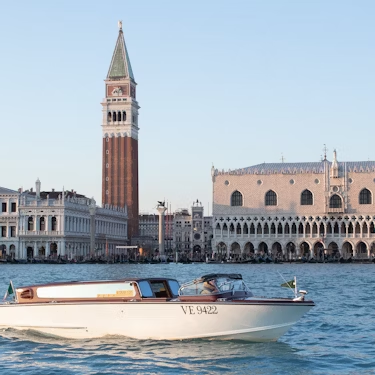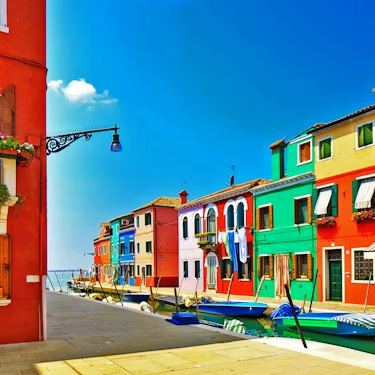More about: 10 Things to Do in Venice in the winter
Winter can definitely be a great time to enjoy all there is to see and do in Venice. In addition to the usual attractions for visitors, this time of year includes two of the city's biggest festivals: Christmas and, of course, its fantastic carnival.
Another advantage of spending a few days in Venice in winter is that the number of tourists is much lower than in summer. This will allow you to stroll around more peacefully and appreciate every detail at your own pace. Add to this the possibility of witnessing events such as the arrival of the Befana or the Festa Veneziana sull'acqua and you're sure to have an unforgettable trip.
1. Visit the Christmas markets and enjoy the illumination of the city.

Winter in Venice is undoubtedly one of the best times to visit the city. In December, for example, all you need to do is stroll through the decorated and illuminated streets and squares to feel immersed in the Christmas spirit, a feeling that will be heightened when you go to one of the markets.
The most outstanding Christmas market in the city is the one in Campo Santo Stefano. With the church of San Esteban as a luxurious backdrop, you will find all kinds of decorative items in the many stalls set up there. Along with these products, there are also toys for children, Venetian masks and the most beautiful Murano glass objects.
While you are browsing the stalls of this market you can also try some speciality grappa, such as the one with a delicious chocolate flavour. Of course, you can opt for a good sparkling wine and accompany it with some of the gastronomic specialities on sale there.
Other markets you're sure to like are those in Campo San Polo, the one in Palazzo Zenobio or the ones set up in Mestre.
However, the Santo Stefano market also has the advantage of its proximity to the Grand Canal. In fact, my advice would be that after leaving the market, cross the canal and go to the Rialto Bridge area, a perfect place to buy some gifts or have a bite to eat in the bars and restaurants that abound there.
2. Go to one of the many concerts in the Venetian winter.

Classical music lovers or simply those who want to enjoy one of the city's most beautiful settings should know that the winter season in Venice offers a wealth of options, from those that take place to bid farewell to the year to those held in the prison of the Doge's Palace.
To begin with, the winter sees the start of the great opera season at the Teatro La Fenice. During the following months all opera lovers will have the opportunity to attend performances in one of the cradles of the genre in the world.
Special events include the Concerto del Capodanno, the traditional New Year's concert held every January 1st. However, the same repertoire can also be heard on the preceding days, between 28 and 31 December.
Another great venue for concerts throughout the summer season is the church of San Vidal, just a few steps from the Grand Canal. Many of these concerts are dedicated to the music of Vivaldi.
The Scuola Grande San Teodoro, as part of its cultural programme, also offers Venetians and tourists a large number of concerts. The most outstanding is its traditional carnival concert in February.
If there is one place that, in principle, could be considered unsuitable for musical performances, it is the prison of the Doge's Palace. However, for some years now, it has been the setting for a number of spectacular Baroque music concerts.
Finally, concerts are organised in some of the palaces in the city, which you can attend. You just have to hurry to get tickets before they sell out.
3. Only for the brave: start the year with a swim in the Lido
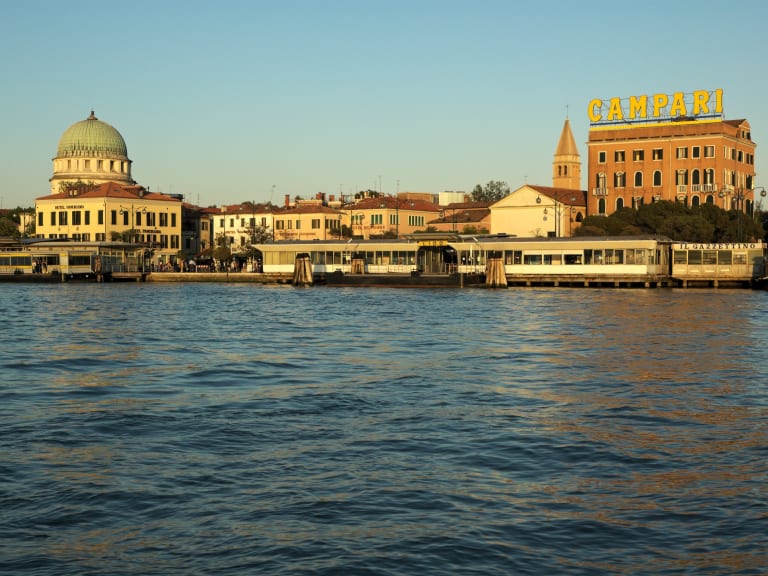
After spending New Year's Eve celebrating the arrival of the new year, the most intrepid Venetians still have a tradition to fulfil: the first swim of the year. If you want to join in (or just be in the area and enjoy the atmosphere) you should be aware that temperatures are usually quite low.
This tradition takes place on the beaches of the Lido, where hundreds of daring bathers come for a brief dip in the icy waters. Of course, the activity is open to anyone who dares, but I advise you to measure your abilities and your state after a night of festivities.
After the swim, the area turns into a small party. Bread rolls, wine and lentils are handed out to those present, all free of charge (although it is customary to leave a small tip). Since there are usually not many tourists, this activity is one of the best ways to get into the authentic atmosphere of Venice.
The best way to get to the Lido is by Venetian vaporetto. In this case, look for the stop at Piazzale Roma. Another option is the train, as there are several lines from Venice that will take you to your destination.
4. Experience the Epiphany and the arrival of the Befana like a child
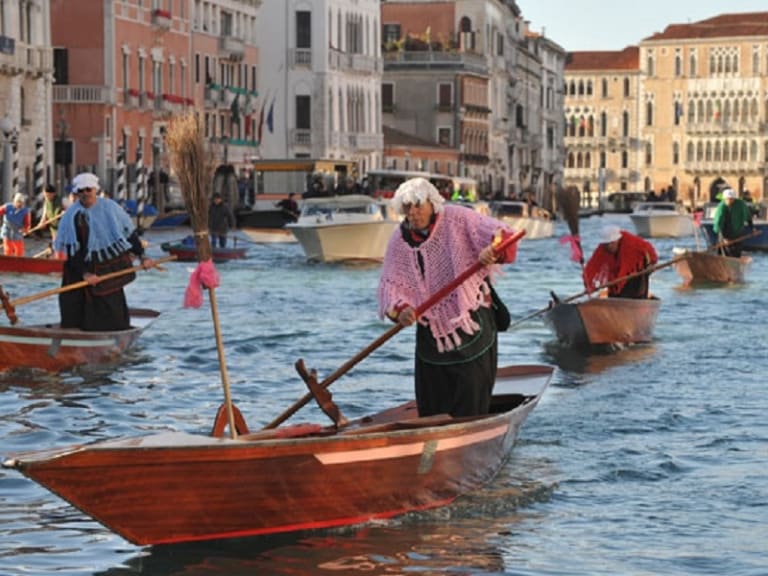
On the 12th day of Christmas, 6 January, Italians celebrate the feast of the Epiphany. On this day, a witch called Befana leaves presents for all the children who have behaved well, as well as coal for the less good ones. In Venice, in addition to the official events, you can enjoy the markets that are set up on that day and eat traditional sweets accompanied by chocolate.
However, what will most attract your attention if you spend that day in Venice is the way of celebrating the arrival of the Befana (here is the legend in case you go to Venice with children and you want to explain it to them). For starters, Venetians dress up as old women and stroll around the city and, in addition, two interesting events are organised that are worth seeing.
The first is a race, the Corsa dea Befana, on the island of Lido. This event involves athletes and amateurs chasing the witch on a motorbike around the city.
The second event is even more interesting. It is the Regatta delle Befane, in which the best members of one of the **city'**s rowing clubs take part. The start is located in San Toma, but I advise you to find a place between the Grand Canal and the Rialto Bridge (one of the most beautiful bridges in Venice) to watch it.
5. Take part in the opening of the carnival at the Festa Veneziana sull'acqua

Grab a mask, get a costume (no matter how elaborate) and head out to enjoy the first events that open the popular Venetian carnival. If you're in town in February, don't miss the two-day Festa Veneziana sull'acqua, with great shows and an interesting regatta.
The Festa Veneziana sull'acqua takes place on the Cannaregio canal (a good place if you're looking for inexpensive restaurants in Venice) during the first weekend of Carnival. On Saturday there's a fabulous water show where various artists perform their best in costumes and masks.
The next day the first regatta of the carnival takes place, the Regata delle Columbine. It starts on the Grand Canal, but the most interesting place is at the finish line, in the Cannaregio itself. Numerous food and mulled wine stalls are set up there, all enlivened by music.
The popularity of these events attracts a large number of Venetians and tourists. For this reason I advise you to go to the venues well in advance to get a good spot.
6. Enjoy the Venice Carnival
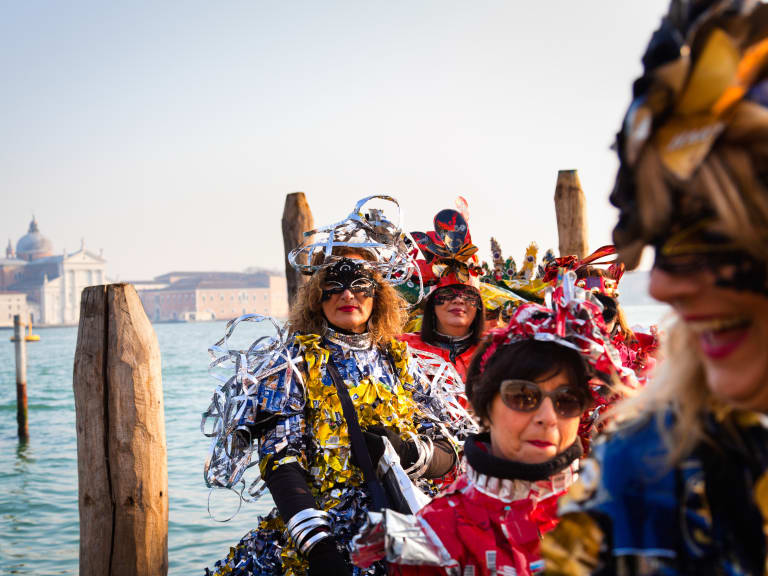
Venice in February equals carnival. Activities begin weeks before the festival officially opens and continue non-stop for the entire 10 or so days of the festival. Leave your shyness behind and take an active part in the events that take place, as I assure you that you won't forget them.
During the carnival days it is traditional to take a gondola ride and listen to a serenade, as well as participate in the balls in the palaces or, if you are not lucky enough to attend, in the city's squares. The Doge's Palace is dressed up with two large masks to welcome these days of fun.
The first thing that may come to mind when talking about Carnival in Venice are the private balls and masks. Many of these private parties have a centuries-old history and have continued to be held in the same palaces where they were held in the 18th century.
Unfortunately, it is not easy to attend one of them. You can only try to attend those that charge an entrance fee, and only if you buy your ticket almost a year in advance. Don't forget that there is a strict dress code: haute couture costume with a historical theme and mask.
It's simpler and less formal to attend any of the parties that take place in St Mark's Square. With a mask and a flashy costume, you can easily pass for a Venetian. As well as enjoying the festivities, you can't miss the gastronomic specialities on sale in the street, especially the sweets.
7. Get to know the traditional Festa de la Marie

The best time to admire the most traditional costumes of Venice is the Festa delle Marie, an event where young women are chosen to participate in one of the most important parades of the carnival and in the traditional Flight of the Lion.
The selection process begins several weeks before the carnival opens, when a pre-selection of candidates is made. One of the requirements is that they all reside in Venice.
Once the 12 Marie's have been chosen, a parade takes place from San Pietro di Castello (the site of the city's ancient basilica) to St Mark's Square. There, each of the Marias is presented to the people of Venice. This parade is visually impressive, as representatives of many historical associations participate in elaborate medieval costumes.
The tradition of the Festa de la Marie was born more than 10 centuries ago. Legend has it that all couples who were to be married had to receive a blessing on the day of the Purification of Mary, 2 February. Twelve of the poorest brides were selected from among the poorest, who were given beautiful borrowed dresses and jewellery to adorn themselves. Afterwards, the Doge himself would receive them in the Doge's Palace and a lavish feast would take place.
The tradition was broken in 973, when the city was attacked by pirates during this celebration. The 12 brides were kidnapped, but the Venetians managed to rescue them shortly afterwards. To commemorate this event the celebration of the Festa de la Marie was established.
8. Say goodbye to Carnival with the Svolo del Leone - The Flight of the Lion

Whether you've had the immense good fortune to spend the entire carnival in Venice or you've just come for the end, the Svolo del Leone ceremony is a must-see. Not only is it a truly beautiful celebration, but it is also a highly evocative event loaded with symbolism. Of course, the festive part with music, drink and food is not to be missed.
The winged lion is the symbol of the city and was already the symbol of the city in the time of the Serenissima Republic. For this event, the lion is depicted on a huge flag of St. Mark, which is hoisted up to the bell tower of the basilica of the same name. Just before, in a crowded square, the winner of the Marie contest is announced.
While this is happening, the musicians of La Fenice play the Hymn of St. Mark. When the flag arrives at its place, a magnificent fireworks display begins, bringing the festival to an end.
9. Escape the cold by visiting the city's underground tunnels

If the cold is biting, you may not feel like being outdoors. A different activity that will allow you to escape the cold for a while is to go down into the city's underground to discover some of its more unknown attractions. Although it may not seem like it, some of Venice's buildings hide interesting crypts and passages.
Walking through these tunnels is definitely a different experience. Normally, visits are made only with the light of a torch or a small lantern that will illuminate from almost forgotten crypts (such as San Simeon Piccolo or San Zaccaria) to some frescoes made underground. There is also a niche filled with catacomb-style skulls.
10. Taste the Venetian winter sweets

Winter in Venice is accompanied by a number of seasonal gastronomic specialities, especially sweets. If you want to fully enjoy the experience of travelling to the City of Canals at this time of year, you must try some of these dishes, either in the streets or on a gastronomic tour.
The first great Venetian speciality is closely linked to the carnival. It is the fritelle, a recipe that seems to have been around for centuries. It is a fritter sold from street stalls a few weeks before the start of the city's big festival. Nowadays, you can find innovations such as nutella or rum fritters.
Another typical dessert of the city is the galani, a type of fried dough similar to castagnole. The main difference is that the latter is served with icing sugar on top.
Weather in Venice during the winter
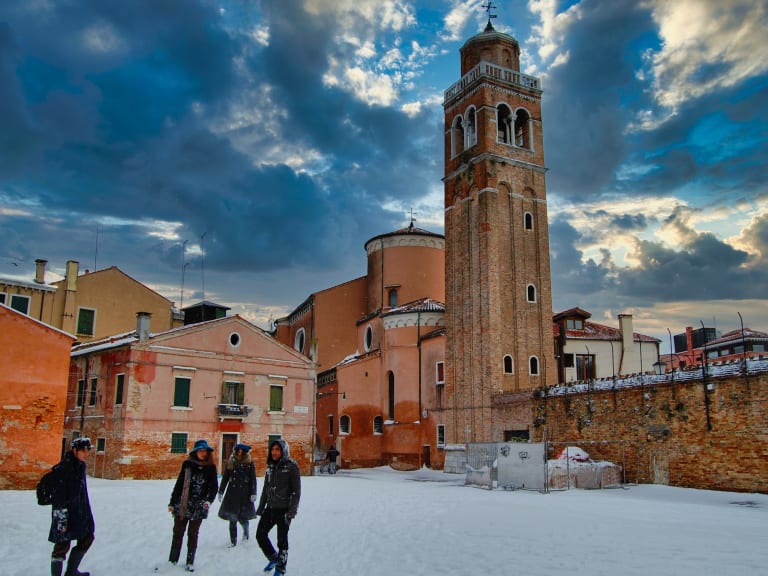
Admittedly, those who hate the cold will find the Venetian weather in winterrather unpleasant. In addition to the low temperatures, the wind chill is made colder by fog, humidity and winds such as sirocco and bora. In any case, it is always advisable to check the forecastbefore travelling.
Even so, there are some differences depending on the date of travel within the winter season:
- December: the second coldest month of the year, with highs of 8º and lows of 1º.
- January: the coldest month. The maximum temperatures barely exceed 8ºC on average, while the minimum temperatures are close to 0ºC. It is also the period with the highest probability of snow.
- February: the second fortnight brings a slight change in temperatures. Maximum temperatures start to approach 10º, although minimum temperatures remain close to 1º on average. In its favour, it is the least rainy month of the year.
- March: the temperature starts to rise and highs reach 13º. At night, however, it is still quite cold, with an average of around 4ºC.
Travel to Venice in the high water season

Although the risk of acqua alta (high water) begins in the autumn months, December is one of the most common months for this phenomenon. In short, the tide rises to levels that cause the streets and squares of the city to be flooded.
An official website lists warnings of possible acqua alta, but the forecast is only reliable for three days. However, most of the time this phenomenon is only a small flood that does not prevent people from living almost normally and, moreover, usually lasts between 2 or 3 hours.
It is quite different when there is a more serious episode of high water. When this happens, the city's sirens sound as a warning and the water can seriously flood some areas.
In addition to consulting these forecasts, my advice is to wear waterproof boots and, above all, to take it easy.
Is it worth travelling to Venice in winter?

Visiting Venice in winter means, on the downside, having to endure the cold. In addition, the daylight hours are quite short, so you will have to plan your tours very well.
However, this season also has advantages that outweigh the disadvantages mentioned above. To begin with, there are far fewer tourists (with the exception of Carnival), which means you can visit the city more comfortably and avoid the crowds. This, in turn, means lower prices for flights and hotels.
In addition, winter in Venice has some really interesting activities. To name but two, in December the Christmas festivities take place, while in February the city's most famous festival, the Carnival, is celebrated. For these reasons alone, it is definitely worth the trip.

